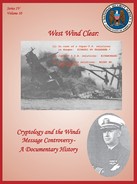Chapter 1. Background: Interwar U.S. – Japan Relations and Cryptology
In the Pacific, the years between the end of the First World War and the attack on Pearl Harbor saw the growth of the strategic rivalry between the United States and Japan in East Asia, especially centered on events in China. Japan had occupied and detached China's industrial north, Manchuria, and created the puppet state of Manchukuo in 1932. In 1937, in response to an incident outside of Beijing, Japan invaded China from the north and east. Tokyo's hopes for a quick campaign faded in the face of Chinese resistance and the sheer territorial enormity of China. Japanese forces could not force a military solution and were mired down. The war absorbed Japan's economic and military resources. Japan's efforts to force a solution to the "China incident" led to the occupation of French Indochina. This action precipitated U.S. (and British and Dutch) embargoes in trade, oil, and the freezing of Japan's assets in 1941. Vulnerable, Japan plunged into planning to seize the resource-rich regions of Southeast Asia and the Netherlands East Indies.
Beginning in 1919, the American Black Chamber focused on exploiting Japanese diplomatic messages. Initial successes in the early 1920s soon vanished. In the mid-1930s, a resurgent U.S. Army mission, the Signals Intelligence Service, began exploiting a number of Japanese diplomatic messages encrypted in manual and machine cipher systems. American cryptanalysis' crowning achievement occurred in September 1940 when it penetrated Japan's primary diplomatic cipher machine, codenamed Purple. As the relations between the two countries deteriorated, Washington's leadership leaned more heavily on the intelligence from its code-breaking organizations for clues to Japan's aims and plans.
